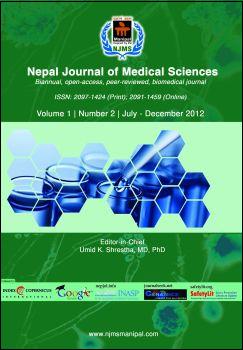Comparative Histological Study on the Spleen of Human (Homo sapiens), Cow (Bos indicus) and Goat (Capra hircus)
DOI:
https://doi.org/10.3126/njms.v1i2.6601Keywords:
Comparative anatomy, histology, spleen, capsule, white pulpAbstract
Background: The spleen is the largest single mass of lymphoid tissue in all vertebrates. It is presumed that the architectural design of spleen of domestic and wild animal is different from man. Exact knowledge of histological structure of human, cow and goat can be helpful to differentiate among different species in vertebrates.
Methods: A descriptive type of study was carried out in the department of Anatomy, Dhaka Medical College, Dhaka, from January to December 2008. Thirty human spleens were collected from the unclaimed dead bodies that were under examination in the Department of Forensic Medicine of Dhaka Medical College, Dhaka. Spleens from cow and goat were collected from a slaughter house of Dhaka city. A total of 15 relatively fresh human samples, six from cows and six from goats were selected for histological study.
Results: The mean thickness of the splenic capsule was 111.56±21.45 ?m in human, 196.88±11.91 ?m in cow and 251.44±12.56 ?m in goat. The difference in thickness of the splenic capsule was statistically significant among the human, cow and goat (p <0.001). However, no difference was found in diameter, number and percentage of the white pulp of the spleen among those species.
Conclusion: There was statistically significant difference in the thickness of splenic capsule but no difference was found in the diameter, number and percentage of white pulp in the spleen of these species.
DOI: http://dx.doi.org/10.3126/njms.v1i2.6601
Nepal Journal of Medical Sciences. 2012;1(2): 64-7
Downloads
Downloads
Published
How to Cite
Issue
Section
License
Copyright © by Nepal Journal of Medical Sciences. The ideas and opinions expressed by authors of articles summarized, quoted, or published in full text in this Journal represents only opinions of authors and do not necessarily reflect the official policy of Nepal Journal of Medical Sciences or the institute with which the author(s) is (are) affiliated, unless so specified.




